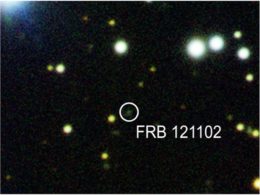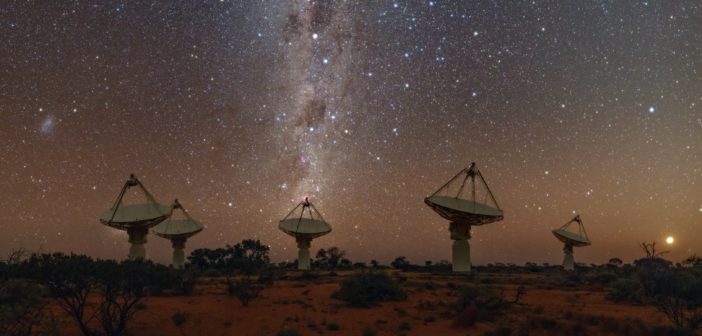New evidence deepens the mystery of fast radio bursts (FRBs), the brief flashes of radio emission stemming from unknown sources beyond our galaxy. Scientists have now discovered faint repeat bursts from one of the brightest FRBs, previously thought to have been a one-off event.
To Repeat or Not to Repeat
It was over a decade ago that scientists noticed the first enigmatic, millisecond-duration burst of radio waves from outside of the Milky Way. Since then, we’ve discovered about 100 FRB sources and even identified the host galaxies for several of them. Nonetheless, we still don’t know what causes FRBs, or even whether they’re all the same type of phenomenon.

FRB 121102, the first fast radio burst found to repeat, was also the first to be localized in the sky. [Gemini Observatory/AURA/NSF/NRC]
We successfully localized one repeating FRB to a distant low-mass, low-metallicity dwarf galaxy. The two non-repeating bursts that we’ve localized, on the other hand, are associated with very massive host galaxies. Does this distinction mean that repeating and non-repeating bursts make up two different classes of FRBs? Or are FRBs all the same type of source, and the difference in host galaxies is just random variation?
Recently, a team of scientists led by Pravir Kumar (Swinburne University of Technology, Australia) has added one more clue to the puzzle: observations of weak repeat bursts from an FRB thought to be non-repeating.

Artist’s impression of the ASKAP radio telescope finding a fast radio burst. Other observatories are shown joining in follow-up observations. [CSIRO/Andrew Howells]
What Are We Missing?
Kumar and collaborators were testing a simple theory: What if FRBs all repeat, but we don’t have the sensitivity to detect the fainter bursts?
In this scenario, supposed one-off FRBs are actually just the most energetic bursts from repeating sources. If we carefully study very sensitive observations of the region around a non-repeating burst, the team reasoned, we might find evidence of other bursts from the same source.
The authors chose FRB 171019 as their target — one of the brightest bursts found in a recent survey conducted with the Australian Square Kilometre Array Pathfinder (ASKAP). Kumar and collaborators used ASKAP itself, as well as the 64-meter Parkes radio telescope and the 110-meter Green Bank Telescope, to conduct follow-up observations of the 10’ x 10’ region FRB 171019 was determined to have originated from.
Faint Flashes Found

Timeline of the ASKAP, Parkes, and Green Bank Telescope observations in the direction of FRB 171019. Red circles mark observed bursts. Click to enlarge. [Kumar et al. 2019]
This discovery lends credence to the idea that more seemingly one-off bright FRBs may actually have faint repetitions that we’ve simply missed — and these sources may be found to repeat if we conduct follow-up with more sensitive telescopes. Understanding this brings us one step closer to discovering the nature of these mysterious sources.
Citation
“Faint Repetitions from a Bright Fast Radio Burst Source,” Pravir Kumar et al 2019 ApJL 887 L30. doi:10.3847/2041-8213/ab5b08

16 Comments
Pingback: From SKA via AAS NOVA: ” Faint Repetitions of an Extragalactic Burst” | sciencesprings
Pingback: GBT Detects Super-Quiet Repeating Fast Radio Burst - Green Bank Observatory
Pingback: Faint Repetitions of an Extragalactic Burst - Worldika - New Platform For Explore World
Pingback: Faint Repetitions of an Extragalactic Burst – Dinezh.com
Pingback: Faint Repetitions of an Extragalactic Burst – Digital VanLife Magazine
Pingback: Faint Repetitions of an Extragalactic Burst – Hamilton County Weather
Pingback: Repeticiones débiles de una explosión extragaláctica – Observatori Astronòmic
Pingback: Repeticiones débiles de una explosión extragaláctica « SEDA / LIADA - RedLIADA - Cursos LIADA - Cielo del Mes - Fenómenos Astronómicos - RELEA
Pingback: Repeticiones débiles de una explosión extragaláctica « Sección de Astrofísica de la LIADA
Pingback: Febrero 2020 – Observatori Astronòmic
Pingback: A Quick Radio Burster is seen to repeat each 16 days... deepening the thriller - Binge Post
Pingback: A Fast Radio Burster is seen to repeat every 16 days… deepening the mystery – SYFY WIRE – VIP Tech
Pingback: A Fast Radio Burster is seen to repeat every 16 days… deepening the mystery | CHOCHILINO
Pingback: A Fast Radio Burster is seen to repeat every 16 days... deepening the mystery - Blabba.net
Pingback: Sursauts radio intergalactiques: un cycle, pas de réponse – Enjeux énergies et environnement
Pingback: Sursauts radio intergalactiques: un cycle, pas de réponse – Nouvelles du web